Removing gel nail polish at home can seem like a daunting task, but with the right tools and techniques, it’s both safe and straightforward.
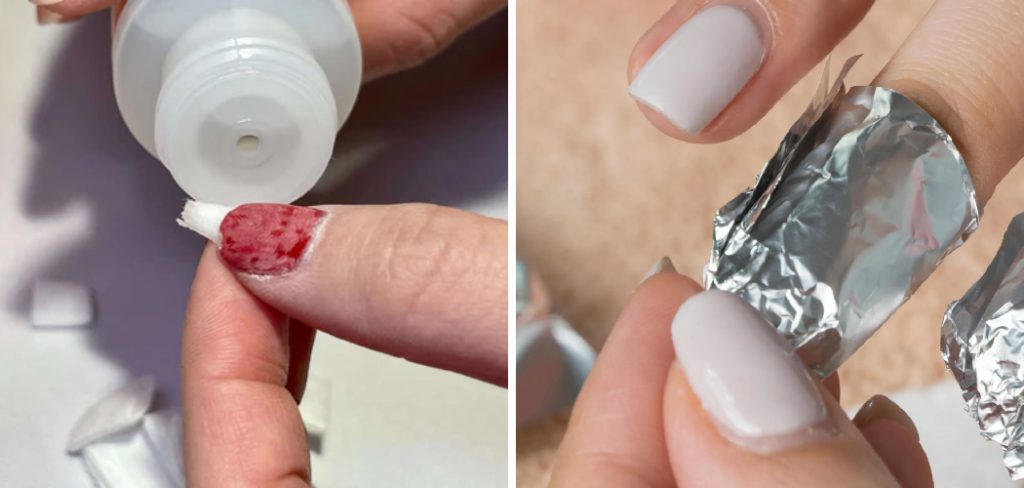
This guide will walk you through the step by step process of how to get gel nail polish off, helping you avoid damage to your natural nails while ensuring an effective removal. Whether you’re preparing to change your nail look or giving your nails a breather, learning how to properly take off gel polish is an essential skill for any nail enthusiast.
The Risks of Peeling or Picking at Gel Nails
While it may be tempting to pick or peel off gel nail polish, doing so can lead to significant damage to your natural nails. Peeling the polish often removes layers of your nail’s surface along with it, weakening the nail plate and making it thin and brittle over time.
This damage can also increase the risk of splitting, cracking, or uneven nail growth. Additionally, picking at gel nails can create an uneven texture and make your nails more susceptible to infections. To keep your nails healthy and strong, it’s essential to resist the urge to peel and follow proper removal methods instead.
Tools and Materials You’ll Need
Before you begin the removal process, it’s important to gather the right tools and materials. Having everything ready will make the process smoother and more effective. Here’s what you’ll need:
- Acetone – 100% acetone works best for breaking down gel polish.
- Cotton Balls or Pads – Used to hold the acetone against your nails.
- Aluminum Foil – Small pieces will be used to wrap your nails securely.
- Nail File – A coarse nail file to gently buff the top layer of the gel polish.
- Cuticle Pusher or Orangewood Stick – For safely pushing off softened gel polish.
- Nail Buffer – To smooth and even the surface of your nails after removal.
- Cuticle Oil or Hand Cream – To rehydrate and nourish your nails and skin post-removal.
Having these items ready beforehand will help ensure a gentle and efficient removal process, keeping your nails healthy and strong.
10 Proven Methods on How to Get Gel Nail Polish off
Gel nail polish is the go-to for anyone who loves long-lasting, glossy nails. However, removing it can sometimes feel like a daunting task, especially if you’re determined to avoid damaging your nails. Luckily, with the right techniques and tools, you can safely remove gel polish at home without risking harm to your nail health.
Here are 10 easy and effective ways to get gel nail polish off—so you can keep your nails looking their best.
1. Use 100% Acetone for a Classic Removal Method
The easiest and most effective way to remove gel nail polish is with 100% acetone. Acetone breaks down the gel polish quickly, making it easy to scrape off.
- How to: Saturate a cotton ball with acetone, place it on your nail, and wrap it in aluminum foil. Leave it on for 10-15 minutes before gently pushing off the softened gel with a cuticle stick.
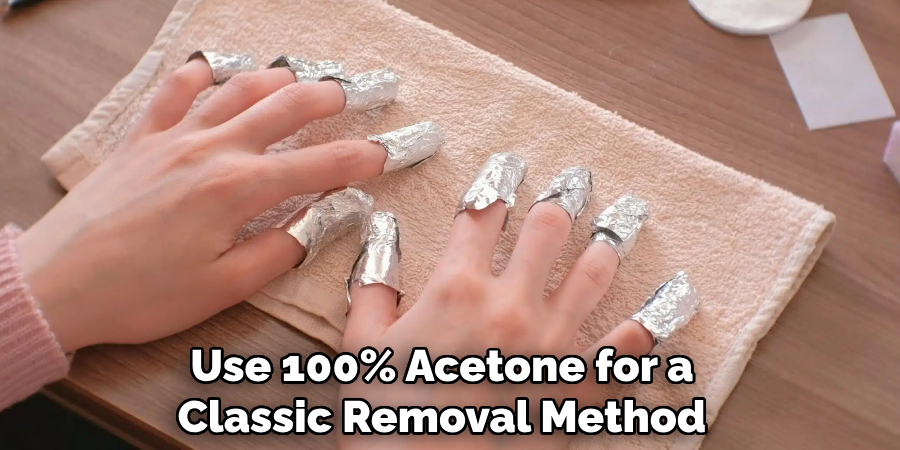
2. Try Non-Acetone Polish Removers
If you prefer a less harsh alternative, non-acetone removers can work, albeit more slowly. These are gentler on your nails and skin but may require more effort.
- Tip: Look for removers that include other moisturizing agents to protect your nails from drying out.
3. Use a Nail Polish Remover Pad
Many brands offer pre-soaked remover pads that can simplify the process. These are small pads fully infused with acetone or non-acetone removers and prepped for easy use.
- Example Bonus: They’re especially useful for removing gel polish while on the go.
4. File the Gel Polish Away
If you’re truly averse to soaking your nails in any liquid remover, filing is another effective method. Use a nail file to gently buff away the top layer of gel polish.
- Caution: Focus on long, gentle strokes to avoid damaging your natural nails beneath.
5. Remove with a Nail Steamer
For those looking for a high-tech solution, nail steamers can help loosen gel polish without as much manual effort.
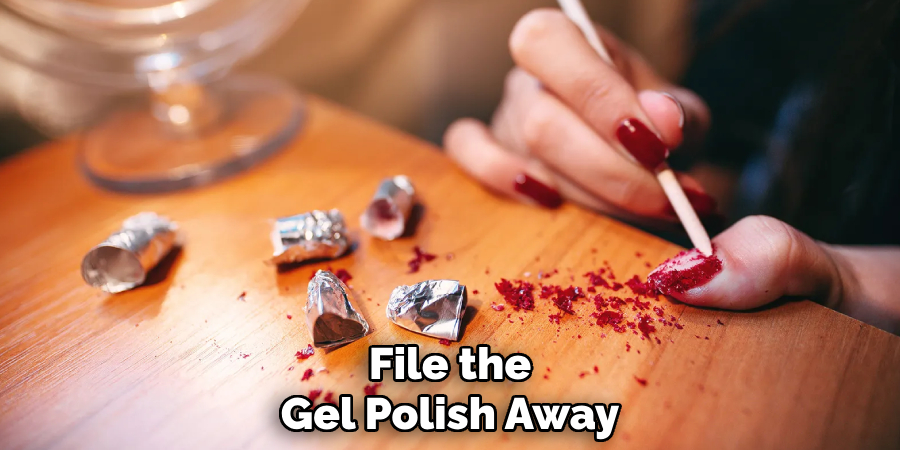
- How it Works: The device uses heat and steam to break down the gel, making scraping much easier while reducing dryness to nails and skin.
6. Try Warm Water and Soap (For Lighter Gels)
Some lighter types of gel polish can be loosened by soaking your nails in warm soapy water for 15 to 20 minutes.
- Tip: Gently push off the softened polish afterward using a cuticle stick.
7. Use Cuticle Oil for Added Moisture
Combine cuticle oil with acetone to better protect your nails from drying. While acetone on its own can be harsh, adding a few drops of oil helps keep your nails hydrated.
- Bonus Benefit: This method also nourishes your cuticles during the removal process.
8. Try a Gel Polish Removal Kit
Investing in a gel polish removal kit saves time and ensures you’re using tools specifically designed for the job. Most kits come with acetone-soaked wraps, a scraper tool, and a buffer for aftercare.
- Tip: Perfect for frequent gel nail enthusiasts.
9. Use Rubbing Alcohol as a Last Resort
If you’re out of acetone, rubbing alcohol can work in a pinch. It’s less effective but can still weaken the bond of the gel polish.
- How to: Saturate a cotton ball, place it on your nail, and allow it to sit for 10-15 minutes before scraping gently.
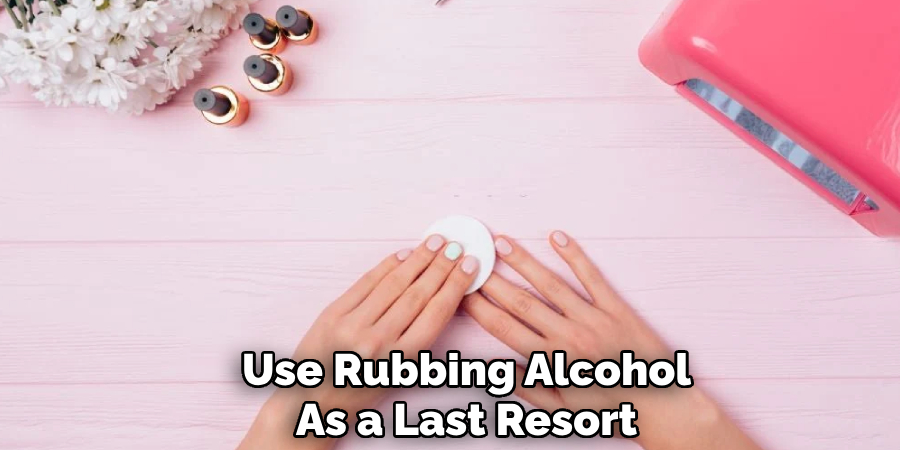
10. Never Peel or Pick at Your Gel Polish
While this isn’t a removal method, it’s an essential rule! Peeling off gel polish can severely damage your nail bed, leading to long-term issues such as brittleness and thinning nails.
- Alternative: Always opt for a safe removal technique like the ones listed above.
Maintenance and Upkeep
Proper maintenance and care after removing gel nail polish are crucial for ensuring your nails remain healthy, strong, and beautiful. Here are some tips to help you restore and protect your natural nails after the removal process:
Moisturize Regularly
Hydration is key to maintaining healthy nails and cuticles. Apply a rich cuticle oil daily to nourish and strengthen your nails. Follow up with a hand cream to keep your skin soft and hydrated.
Buff and Smooth
Use a gentle nail buffer to smooth out any rough spots or ridges on your nails caused by the gel polish. This will create an even surface and enhance the natural appearance of your nails.
Apply a Strengthening Treatment
Strengthening nail treatments or hardeners can help reinforce thin or weak nails. Look for products containing keratin or biotin, which promote nail growth and durability.
Avoid Over-Polishing
Give your nails time to recover by avoiding gel or regular polish for at least a week or two. This allows your nails to breathe and naturally replenish their strength.
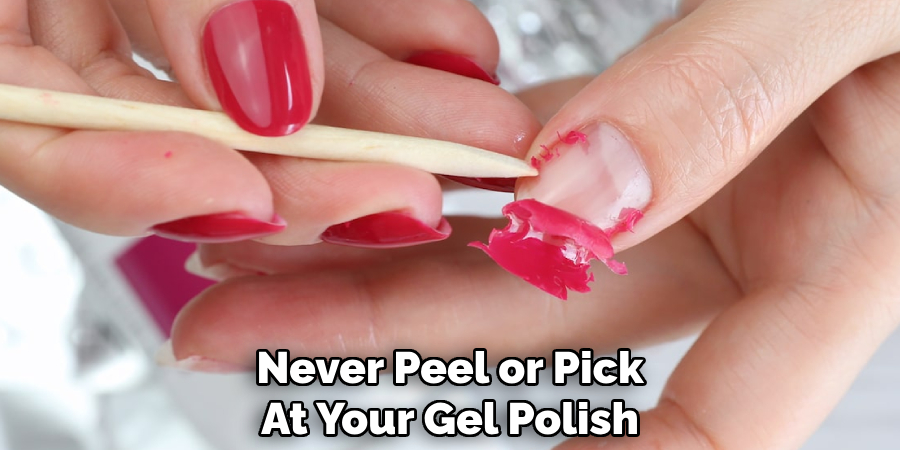
Keep Nails Trimmed and Filed
Trim your nails regularly to prevent splitting or breaking. File them gently in one direction to maintain their shape without causing damage.
Wear Gloves During Chores
Protect your nails and hands from harsh chemicals or excessive moisture by wearing gloves while doing household chores, such as cleaning or washing dishes.
Troubleshooting Common Issues
Even with the best removal techniques and post-care practices, you may encounter some common nail problems. Here’s how to handle them effectively:
1. White Spots or Streaks
White spots or streaks on your nails often appear after gel polish removal, especially if nails were over-buffed or dried out.
- Solution: Hydrate your nails with cuticle oil and hand cream daily. Consider using a nail strengthener to protect the surface and reduce further damage.
2. Thin or Weak Nails
Using harsh removal methods or peeling off gel polish can leave your nails feeling thin or brittle.
- Solution: Apply a nail hardener or a strengthening treatment containing keratin. Avoid using polish for a few weeks, and stick to a healthy nail care routine to promote natural regrowth.
3. Peeling or Splitting
Nails can sometimes split or peel, especially if they were scraped or filed too aggressively during gel removal.
- Solution: Keep your nails trimmed and use a nourishing nail oil daily. File gently to prevent further peeling, and avoid applying any gel or polish until your nails have fully recovered.
4. Persistent Gel Residue
If small bits of gel polish remain on your nails after using a removal method, they can feel rough or uneven.
- Solution: Use a soft nail buffer to gently remove the leftover residue without damaging your nail. Avoid scraping too hard as it can harm your nail bed.
5. Staining or Discoloration
Nails may develop discoloration if polish is worn for extended periods without a protective base coat.
- Solution: Use a whitening treatment designed for nails or soak them in a mix of warm water, lemon juice, and baking soda. Moving forward, always use a base coat before applying gel polish to prevent stains.
Conclusion
Removing gel nail polish doesn’t have to be a daunting task if approached with the right methods and tools. By prioritizing gentle, effective techniques and incorporating a proper aftercare routine, you can protect your nails from unnecessary damage and maintain their natural strength and beauty.
Remember, healthy nails are the foundation for stunning manicures, so take the time to invest in their care. So, there you have it – a quick and easy guide on how to get gel nail polish off.
About the Author
Jane Hubbard is a passionate beauty expert with a wealth of experience in makeup, hair, and overall beauty techniques. After years of working as a hairdresser specialist, she followed her entrepreneurial spirit and started her own consultancy business.
Jane has always been driven by her desire to help others feel confident in their own skin, and she does this by sharing her knowledge, experiences, and practical beauty tips. Through her consultancy, she empowers individuals to embrace their unique beauty, offering tailored guidance that boosts both self-esteem and personal style.
Professional Focus
- Specializes in makeup, hairstyling, and beauty consulting.
- Provides personalized beauty advice, tips, and techniques to help individuals feel confident in their appearance.
- Dedicated to staying up-to-date with the latest industry trends and developments.
- Passionate about creating a comfortable and empowering experience for every client.
Education History
- University of Craft and Design – Bachelor of Fine Arts (BFA) in Woodworking and Furniture Design
- Woodworking Apprenticeships – Extensive hands-on training with skilled craftsmen to refine carpentry and furniture making techniques
- Online Courses & Masterclasses – Continued education in advanced woodworking techniques, design principles, and specialized tools
Expertise:
- Makeup artistry, hairstyling, and beauty consulting.
- Personalized beauty techniques to enhance confidence and self-expression.
- Educating clients on how to maintain their beauty routines at home.
